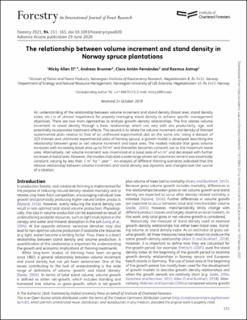| dc.description.abstract | An understanding of the relationship between volume increment and stand density (basal area, stand density index, etc.) is of utmost importance for properly managing stand density to achieve specific management objectives. There are two main approaches to analyse growth–density relationships. The first relates volume increment to stand density through a basic relationship, which can vary with site productivity, age, and potentially incorporates treatment effects. The second is to relate the volume increment and density of thinned experimental plots relative to that of an unthinned experimental plot on the same site. Using a dataset of 229 thinned and unthinned experimental plots of Norway spruce, a growth model is developed describing the relationship between gross or net volume increment and basal area. The models indicate that gross volume increases with increasing basal area up to 50 m2 and thereafter becomes constant out to the maximum basal area. Alternatively, net volume increment was maximized at a basal area of 43 m2 and decreased with further increases in basal area. However, the models indicated a wide range where net volume increment was essentially constant, varying by less than 1 m3 ha−1 year−1. An analysis of different thinning scenarios indicated that the relative relationship between volume increment and stand density was dynamic and changed over the course of a rotation. | |
